United States Public Health Service Commissioned Corps
| United States Public Health Service Commissioned Corps | |
|---|---|
 USPHS Commissioned Corps centennial emblem fashioned after the Corps' official Seal. | |
| Active | 4 January 1889[1][2]–present |
| Country |
|
| Allegiance | Constitution of the United States |
| Branch |
|
| Type | Uniformed service |
| Role | Healthcare and medical services |
| Size | 6,800+ officers[3] |
| Part of |
|
| Headquarters |
Division of Commissioned Corps Personnel and Readiness Rockville, Maryland |
| Motto(s) | "Protecting, promoting and advancing the health and safety of the Nation!" (core values: Leadership, Service, Integrity, and Excellence) |
| Colors | Blue and gold |
| Anniversaries | Centennial 1989 |
| Engagements | |
| Decorations |
|
| Commanders | |
| Surgeon General | VADM Vivek H. Murthy |
| Deputy Surgeon General | RADM Sylvia Trent-Adams |
| Notable commanders |
RADM Luther Leonidas Terry VADM Julius B. Richmond VADM C. Everett Koop ADM James O. Mason ADM David Satcher ADM John O. Agwunobi ADM Joxel García |
| Insignia | |
| Flag of the U.S. Public Health Service |
 |
The United States Public Health Service Commissioned Corps (PHSCC),[5] also referred to as the Commissioned Corps of the United States Public Health Service, is the federal uniformed service of the U.S. Public Health Service (PHS) and is one of the seven uniformed services of the United States.
Along with the National Oceanic and Atmospheric Administration Commissioned Officer Corps, the Public Health Service Commissioned Corps is one of two uniformed services that consist only of commissioned officers and has no enlisted or warrant officer ranks, although warrant officers have been authorized for use within the service.[6] Officers of the PHS are classified as noncombatants, unless directed to serve as part of the armed forces by the President or detailed to a service branch of the armed forces.[7] Members of the PHSCC wear the same uniforms as the United States Navy and the United States Coast Guard (when assigned to the Coast Guard) with special corps insignia, and hold ranks equivalent to officers of U.S. Navy and U.S. Coast Guard. Officers of the PHSCC receive their commissions through the PHSCC's direct commissioning program.
As with its parent division, the PHS, the PHSCC is under the direction of the United States Department of Health and Human Services. The PHSCC is led by the Surgeon General who holds grade of vice admiral.[8] The Surgeon General reports directly to the Assistant Secretary for Health who may hold the rank of admiral if he or she is a serving member of the PHSCC.[8]
History
The Public Health Service Commissioned Corps had its beginnings with the creation of the Marine Hospital Fund in 1798, which later was reorganized in 1871 as the Marine Hospital Service. The Marine Hospital Service was charged with the care and maintenance of merchant sailors, but as the country grew, so did the ever-expanding mission of the service. The Marine Hospital Service soon began taking on new expanding health roles that included such health initiatives that protected the commerce and health of America. One such role was quarantine.
John Maynard Woodworth, a famous surgeon of the Union Army who served under General William Tecumseh Sherman, was appointed in 1871 as the Supervising Surgeon. Woodworth's title was later changed to "Supervising Surgeon General," which later became the Surgeon General of the United States. Woodworth is credited with the formal creation of the Commissioned Corps. Woodworth organized the Marine Hospital Service medical personnel along Army military structure in 1889 to facilitate a mobile force of health professionals that could be moved for the needs of the service and country. He established appointment standards and designed the Marine Hospital Service herald of a fouled anchor and caduceus. Later that year of 1889, President Grover Cleveland signed an Act into law that formally established the modern Public Health Service Commissioned Corps (then the Marine Hospital Service under the Supervising Surgeon (later Surgeon General)). At first open only to physicians, over the course of the twentieth century, the Corps expanded to 11 careers in a wide range of specialties to include physicians, veterinarians, dentists, engineers, pharmacists, nurses, environmental health specialists, scientists, dietitians, and other health professionals.[9]
Today, the PHSCC is under the United States Public Health Service (PHS), a major agency now of the U.S. Department of Health and Human Services (HHS), established by Congress in 1979-1980. It was previously established in 1953 as the U.S. Department of Health, Education and Welfare (HEW), and is still led by the Surgeon General. The PHSCC allocates officers to all seven uniformed services depending on the health or medical needs of the other uniformed services. The PHSCC was featured in the 1950 motion picture Panic in the Streets, in which Richard Widmark portrayed a Public Health Service physician tracking down a bubonic plague victim.
Purpose
The stated mission of the Commissioned Corps of the U.S. Public Health Service is "Protecting, promoting, and advancing the health and safety of the Nation" in accordance with the Corps four Core Values: Leadership, Excellence, Integrity, and Service. Officers execute the mission of the Corps in the following ways:
- Help provide healthcare and related services to medically underserved populations: to American Indians, Alaska Natives, and to other population groups with special needs;
- Prevent and control disease, identify health hazards in the environment and help correct them, and promote healthy lifestyles for the nation's citizens;
- Improve the nation's mental health;
- Ensure that drugs and medical devices are safe and effective, food is safe and wholesome, cosmetics are harmless, and that electronic products do not expose users to dangerous amounts of radiation;
- Conduct and support biomedical, behavioral, and health services research and communicate research results to health professionals and the public; and
- Work with other nations and international agencies on global health problems and their solutions.
Plus, the Corps provides officers (Medical Officers, Dental Officers, Therapists, Environmental Health Officers, etc.) to other uniformed services, primarily the United States Coast Guard and the National Oceanic and Atmospheric Administration Commissioned Officer Corps. Corps officers may be detailed to other federal agencies including the Department of Defense, TRICARE, Department of Justice (Federal Bureau of Prisons), State Department, Department of Homeland Security, and the Department of the Interior (National Park Service). Corps officers may develop individual memoranda of understanding (MOUs) with other organizations, including state and local health agencies, and even non-governmental organizations (NGOs).
The Commissioned Corps is often called upon by other federal, state, and local agencies to aid and augment in times when their resources are overwhelmed. These responses are designated as deployments by the PHSCC, if the deployment is outside of the officer's "normal"duties and coordinated through the PHSCC's Readiness and Deployment Operations Group (REDDOG) in the Division of Commissioned Corps Personnel and Readiness (DCCPR).[10] Deployments may be for technical needs in standard settings, or in the event of disasters, in austere environments.
Deployments
The corps is often deployed as part of the National Response Framework Emergency Support Function #8 – Public Health and Medical Services, but can be deployed outside of the framework for various needs to other federal agencies, states, local governments, or even to aid foreign governments. Like all other federal-level responses, officers are deployed only upon request, and upon the recommendation of the Surgeon General and permission of the Assistant Secretary for Health. During deployments, officers may report to regular office spaces, such as coordinating responses at state-of-the-art emergency operations centers, or into the field in extremely austere environments, such as when responding to a natural disaster. In addition, deployments may either be on an individual basis, such as when specific skill sets are needed, or as part of a team, when large-scale responses are needed.
The Corps uses a tiered system of response, with Tier 1 response teams ready and able to respond to an event within 12 hours, and Tier 2 teams ready and able to respond within 36 hours. Officers not on Tier 1 or 2 teams are Tier 3 responders, ready and able to respond to an event in 72 hours. Tier 1 teams are primarily made up of Rapid Deployment Force (RDF) teams that are made up of over 100 officers with multiple specialties, and are focused on providing acute clinical care of disaster-exacerbated chronic conditions. Officers who do not work as a clinical care provider on one of these teams are often in support roles, such as logistics, administration/finance, or planning. Tier 2 teams are composed of a smaller, more specialized workforce. Current Tier 2 teams include the Applied Public Health Team (APHT), the Mental Health Team (MHT), and the Services Access Team (SAT). Officers not already assigned to one of the Tier 1 and Tier 2 teams are Tier 3, and are used to augment these teams in the event of staffing shortages due to availability, or the need to scale up a response.
Some notable recent deployments involving the Public Health Service Commissioned Corps:
- 1989 – Hurricane Hugo; Loma Prieta, California earthquake.
- 1992 – More than 1000 PHS officers were deployed to South Dade County, Florida following Hurricane Andrew.
- Early 1990s – Flooding throughout the United States and Alaska.
- 1994 – Northridge, California earthquake.
- 1995 – Bombing of the Alfred P. Murrah Federal Building in Oklahoma City, Oklahoma.
- 1995 – Hundreds of PHS officers were deployed to the U.S. Virgin Islands following Hurricane Marilyn.
- 2001 – More than 1,000 PHS officers were deployed to New York City after the attacks on September 11, 2001 to aid victims and provide medical and mental health services to responders and rescue workers.
- 2004 – Hurricane Ivan.
- 2005 – More than 2,000 PHS officers deployed to set up field hospitals and render aid and assistance to evacuees and responders in the wakes of Hurricane Katrina, Hurricane Rita, and Hurricane Wilma.[11]
- 2008 – PHS-2 Rapid Deployment Force deployed pre-landfall to Louisiana in advance of Hurricane Gustav. It became the first standing PHS team to set up and run a Federal Medical Station. The team and 200 patients rode out the hurricane in Alexandria's Riverfront Center. RDF-1 and RDF-3 deployed pre-landfall in advance of Hurricane Ike to set up Federal Medical Stations in College Station, Texas and Baton Rouge, Louisiana, respectively.
- 2010 – Haiti earthquake; Deepwater Horizon oil spill in the Gulf of Mexico.
- 2012 – Hurricane Sandy.[12]
- 2014 – Unaccompanied Minor Children immigration crisis.
- 2014-2015 – Ebola outbreak response.[13]
- 2016–present – Great Plains region of the Indian Health Service.
In addition to disaster response, the Public Health Service Commissioned Corps has been partnering with the United States Navy on their health diplomacy missions. Corps officers have been part of the Navy's Pacific Partnership (in the Pacific basin) and Continuing Promise (in the Caribbean/west Atlantic) since 2007. Such missions are often carried out on either the USNS Mercy (T-AH-19) or USNS Comfort (T-AH-20), though other ships, such as the USS Bataan (LHD-5), have also been used. The command staff of the corps are deployed for the entire mission duration (often three months), while operational personnel serve one month aboard, meeting and departing the ships at the ports of call during the mission.
The corps, as a uniformed service, may be militarized and considered a branch of the armed forces by an act of Congress, or by executive order by the President of the United States, not only in time of war, but in "an emergency involving the national defense proclaimed by the President." Major militarization of the corps occurred during World War II and another later during the Korean War.[14]
Commissioned officers
| Commissioned officer ranks, titles and abbreviations of the United States Public Health Service Commissioned Corps | ||||||||||
|---|---|---|---|---|---|---|---|---|---|---|
| Admiral | Vice Admiral | Rear Admiral | Rear Admiral (lower half) | |||||||
| O-10 | O-9 | O-8 | O-7 | |||||||
 |
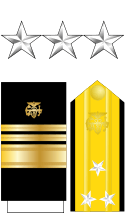 |
 |
 | |||||||
| Assistant Secretary for Health | Surgeon General | Deputy Surgeon General or Assistant Surgeon General |
Assistant Surgeon General | |||||||
| ADM | VADM | RADM | RADM[15] | |||||||
| Captain | Commander | Lieutenant Commander |
Lieutenant | Lieutenant (junior grade) |
Ensign |
|---|---|---|---|---|---|
| O-6 | O-5 | O-4 | O-3 | O-2 | O-1 |
 |
 |
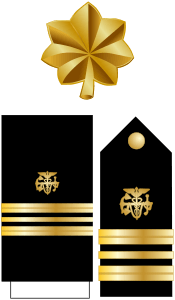 |
 |
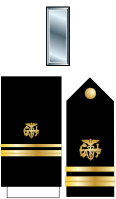 |
 |
| Director | Senior | Full | Senior Assistant | Assistant | Junior Assistant |
| CAPT | CDR | LCDR | LT | LTJG | ENS |
The members of the Commissioned Corps number over 6,600 officers in 11 professional categories:
- Dentist
- Dietitian
- Engineer
- Environmental health officers
- Health service officers
- Nurse
- Medical
- Pharmacist
- Scientist
- Therapist (including physical, occupational, speech, respiratory)
- Veterinarian
The Health Services Officer (HSO) category comprises over 50 specialties, including audiology, social workers, physician assistants, optometrists, statisticians, computer scientists, dental hygienists, medical records administrators, medical technologists and others.
The Corps uses the same commissioned officer ranks as the United States Navy and Coast Guard from ensign to admiral, uniformed services pay grades O-1 through O-10 respectively. USPHS Commissioned Corps officers are appointed via direct commission and receive the same pay as other members of the uniformed services. They cannot hold a dual commission with another service but inter-service transfers are permitted.
Warrant officers
The Corps is authorized to use warrant officer ranks W-1 to W-4 under the U.S. Code of law,[16] but does not currently use these ranks.
Uniforms
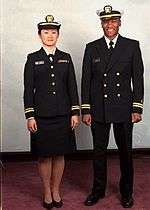
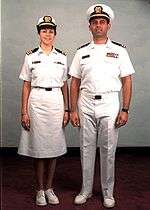
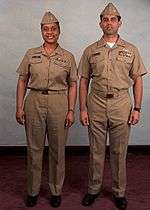
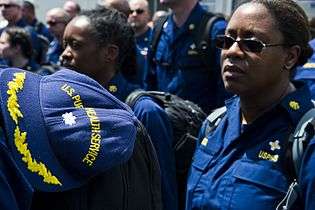
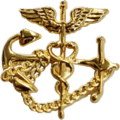

Corps officers wear uniforms similar to those of the United States Navy with special PHSCC insignia. In certain duty situations, a PHSCC officer can be allocated to another uniformed service. For example, the NOAA Corps do not commission medical officers onboard ships so the PHSCC allocates officers to them. The PHSCC allocates and details a number of officers to the United States Coast Guard. Because of this close relationship, if a PHSCC officer is on assignment with the Coast Guard, the officer is required to wear the same service uniforms as regular Coast Guard officers, but still bearing PHSCC insignia to identify them. The PHSCC officer is subject to grooming standards of the service to which attached for uniform appearance.
March of the United States Public Health Service
Like the other U.S. uniformed services, the U.S. Public Health Service has a march and accompanying lyrics. Composed by retired U.S. Coast Guard Senior Chief Musician George King III, the lyrics are as follows:
The mission of our service is known the world around
In research and in treatment no equal can be found
In the silent war against disease no truce is ever seen
We serve on the land and the sea for humanity
The Public Health Service Team[17]
See also
- Awards and decorations of the Public Health Service
- National Oceanic and Atmospheric Administration Commissioned Corps
References
- ↑ PHS Commissioned Corps Celebrate 125 Years
- ↑ About the Commissioned Corps History
- ↑ U.S. Public Health Service Commissioned Corps
- 1 2 3 History of the PHS Commissioned Corps
- ↑ U.S. Public Health Service Commissioned Corps - About Us
- ↑ 42 USC 204 Notes: 1979 - Pub. L. 96–76 inserted provisions relating to appointment and status of warrant officers
- ↑ UCMJ S 802. Art. 2. Subs. (a). Para. (8)
- 1 2 "U.S. Public Health Service Commissioned Corps". U.S. Department of Health and Human Services. Retrieved 24 June 2008.
- ↑ "USPHS: Career & Benefits". usphs.gov. Retrieved 2016-11-06.
- ↑ "Commisisoned Corps Deployments: Public Health Emergency Responders". www.usphs.gov. September 19, 2014. Retrieved 2016-11-06.
- ↑ DCP.PSC.gov
- ↑
- ↑
- ↑ DCP.PSC.gov
- ↑ "HHS Promotion Letter" (PDF). Retrieved 5 November 2012.
- ↑ 42 U.S.C. § 204 - Commissioned Corps and Ready Reserve Corps
42 U.S.C. § 207 - Grades, ranks, and titles of commissioned corps
42 U.S.C. § 209 - Appointment of personnel - ↑ https://web.archive.org/web/20130107225808/http://videocast.nih.gov/closedcaptions/phs120612.txt
Further reading
- Fitzhugh, Mullan. Plagues and Politics: The Story of the United States Public Health Service. New York: Basic Books, 1989. ISBN 0-465-05779-9; ISBN 978-0-465-05779-5.
